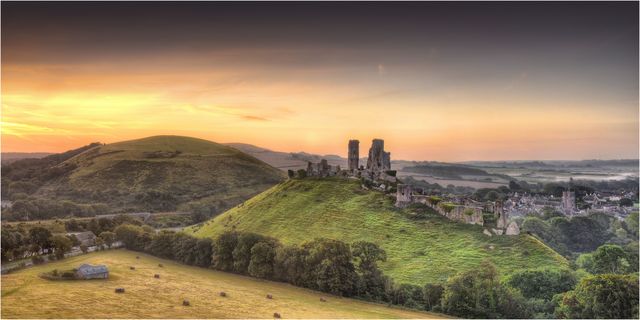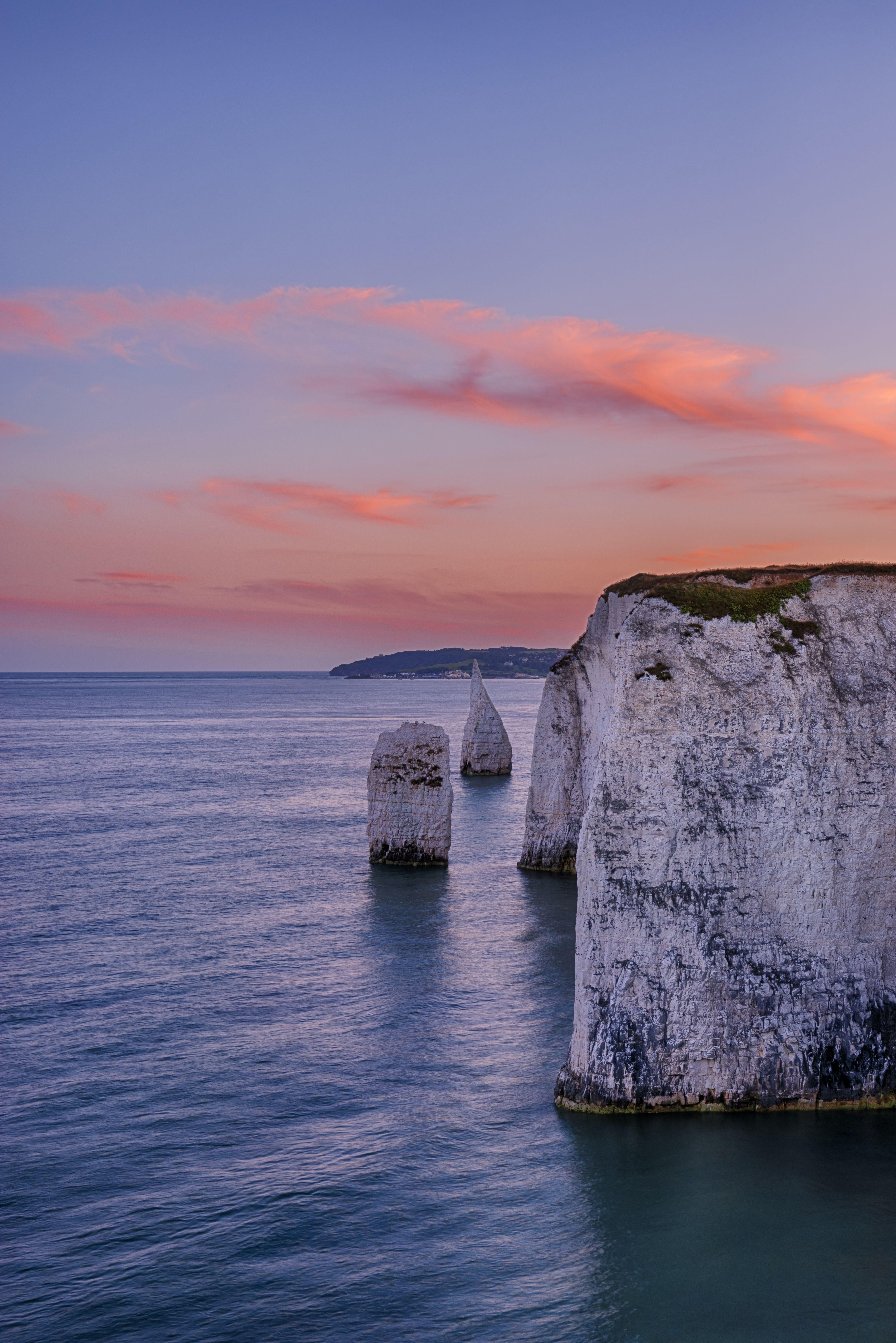
PurbeckGetty: Images
Join Sian Ellis as she takes a trip to the Isle of Purbeck.
The English novelist E M Forster said: “If you wanted to show a foreigner England, perhaps the wisest course would be to take him to the final section of the Purbeck hills, and stand him on their summit, a few miles to the east of Corfe.”
It’s a pretty good recommendation because Dorset’s Isle of Purbeck (actually a 65-sq-mile peninsula) is awash with quintessential features. This 22-mile drive takes in highlights from Swanage to Lulworth Cove: breathtaking World Heritage coast, a ghost village harbouring poignant secrets, three different castles, and landscapes filled with literary adventures.
Kings of the Castles
Begin with a stroll along the promenade at Swanage, enjoying the sights of yachts, golden sands and coloured beach huts sweeping around the bay. A small fishing port until the 19th century, the town transformed into a Victorian seaside resort following the arrival of the railway in 1885, and much architecture from the era, particularly along the High Street, retains a flavour of the times.
If it is open drop into Swanage Museum & Heritage Centre at The Square to peruse interesting displays on the geology of the Jurassic Coast (England’s first natural World Heritage Site); artists and writers from J M W Turner to the Bloomsbury Group who flocked to Purbeck; and the quarrying of local stone. Purbeck Stone and Purbeck Marble – actually fine-polished limestone much used in churches and cathedrals across the UK – have been quarried since Roman times, though the industry peaked in the Victorian era.
The museum tells all about John Mowlem (founder of the international construction firm) and his nephew George Burt (described by Thomas Hardy as the King of Swanage) who prospered from the stone trade and became great philanthropists around town during the 19th century. The men also rescued numerous architectural relics from London and re-erected them in Swanage, leading to its nickname of Old London by the Sea.
Just a few minutes’ drive south you’ll come to ‘King’ George Burt’s restored castle high on the cliffs in 320-acre Durlston Park & National Nature Reserve. Cliffs, downs and meadows here are a haven for flora and fauna, and paths dotted with Victorian panels dispense snippets of poetry and information linking the castle and curious artefacts you’ll come across like Burt’s 40-ton limestone Great Globe. Inside the castle, the Seventhwave café and restaurant will provide you with morning coffee and panoramic views of Swanage Bay and the coast.
Suitably refreshed, now drive the five or six miles from Swanage to Corfe Castle. If you’re with a steam train buff, pack them onto the scenic Swanage Railway that runs to Corfe and meet them at the other end where the picturesque village is overlooked by the jagged hilltop ruins of the castle. The 1,000-year history of Corfe Castle seethes with tales of treachery: a teenage King Edward was murdered here in AD 978, possibly on the orders of his stepmother, leaving the way clear for his half-brother Ethelred the Unready to take the throne. Later in the Civil War the formidable Royalist Lady Mary Bankes, her daughters and maids took to the battlements to fight off Parliamentarian troops, only for a turncoat within the castle to let the enemy sneak in.
Down the hill, in the nearby 1/20th scale model village, you can see how the castle would have looked in 1646 before Cromwell’s men ‘slighted’ it causing its ruin. The courtyard café here serves light lunches – local specialities include Dorset paté and Dorset Blue Vinney cheese – or try one of the village pubs like The Greyhound Inn serving Dorset crab salad as well as more substantial meals.

Lulworth tales
The quaint heart of Corfe Castle village is worth a wander and to ponder the line from Dorset dialect poet William Barnes inscribed on the war memorial: “Do’set Men Don’t sheame Their Kind.”
It’s a rather poignant sentiment to hold in mind as you then follow the road past patchwork fields to Tyneham. During the Second World War Purbeck was the nerve centre for Britain’s radar research and hosted British and American troops getting ready for D-Day. Evicted by the Army in 1943 so that their homes and land could also be used for training soldiers, Tyneham villagers pinned a handwritten note to the church door: “Please treat the church and houses with care. We have given up our homes where many of us lived for generations to help win the war to keep men free. We shall return one day.” Sadly, they never did, as their lands became absorbed into the Ministry of Defence’s Lulworth Range (used for firing practice) but on most weekends and holiday periods you can still explore this unusual ‘ghost’ village.
Rejoin the rural road westwards and head for the Lulworth Estate whose 17th-century castle once played host to fun-seeking aristocrats and royalty. Don’t miss 15th-century St Andrew’s Church just to the south of the castle; it was rebuilt in 1864 to plans drawn up by an apprentice architect named Thomas Hardy. Better known to us as a writer, Hardy based many scenes from his Wessex novels hereabouts, not least Sergeant Troy’s dip in Lulwind (Lulworth) Cove in Far from the Madding Crowd when he swims “between the two projecting spurs of rock which formed the pillars of Hercules to this miniature Mediterranean” and, swept out to sea, needs to be rescued.
Displays in Lulworth Cove visitor centre tell you more about the 150-million-year-old geological story of how the World Heritage Jurassic Coast and its sea-worn limestone features were formed. Best of all stroll around and look for yourself: horseshoe-shaped Lulworth Cove, the beautiful arch of Durdle Door, Stair Hole and the Fossil Forest.
A cream tea at the Boat Shed Café on the beach or an early supper in the thatched Weld Arms rounds off the day very nicely.
Staying longer
There are plenty of rural hideaways for stays including thatched cottages on the Lulworth Estate, and plenty of reasons to explore some more: walks along the Jurassic Coast, literary trails in the steps of Thomas Hardy and Lawrence of Arabia, a trip to Poole (Europe’s largest natural harbour) and a cruise to Brownsea Island, famed for red squirrels, wildlife and as the birthplace of the Scout movement.
Need to know?
- Swanage is a circa 120-mile / 2.5hr drive from London, via the M25, M3, M27, A31, A349, A35, A351.
- Persistence pays off: after the Civil War Lady Mary Bankes won back her estates and the Parliamentarians even presented her with the keys to Corfe Castle in tribute to her courage
- Lady Mary’s keys can be seen today above the mantelpiece at the Bankes family’s later home, Kingston Lacy, at Wimborne Minster
- Spectacular snowdrops – more than 40 varieties – carpet the gardens at Kingston Lacy from late January to the end of February
- Purbeck’s coast is scattered with curiously named geological features like Old Harry Rocks, said to be named after a 14th/15th-century local pirate Harry Paye
- Poet Rupert Brooke was so intrigued by strangely named Mupe Rocks near Lulworth that he came to visit, accidentally dropped his book into the sea, hired a boat and “plunged wholly naked into that fury of black waters” to retrieve it
- The exclusive peninsula of Sandbanks, crossing the mouth of Poole Harbour, has boasted the world’s most expensive coastal street (2018).





Comments